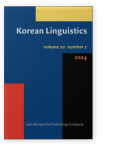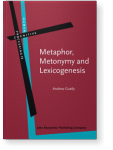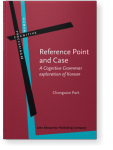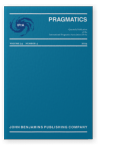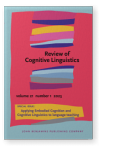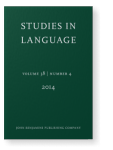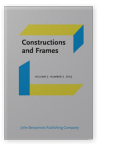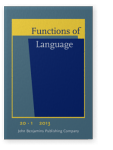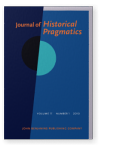Chongwon Park
List of John Benjamins publications for which Chongwon Park plays a role.
Journal
Book series
Title
Reference Point and Case: A Cognitive Grammar exploration of Korean
Chongwon Park
[Human Cognitive Processing, 68] 2019. xx, 264 pp.
Subjects Cognition and language | Cognitive linguistics | Semantics | Syntax | Theoretical linguistics
2024 Notes on word order variation in Korean Pragmatics 34:4, pp. 588–614 | Article
This article aims to develop an analysis of scrambling or word order variation in Korean from a pragmatic/cognitive perspective. Although extensive research has been carried out on this issue, most extant research attempts to provide analyses of the phenomenon by identifying grammatical features… read more
2024 Setting subject and the inferential cleft construction in Korean Review of Cognitive Linguistics: Online-First Articles | Article
This article aims to develop a cognitive-functional analysis of the Korean inferential cleft construction (ICC) by identifying two motivations. It is demonstrated that the ICC must be understood as a mechanism to improve coherence and relevance in the text; it is first and foremost motivated to… read more
2023 The Factive, IHRC, and Cleft constructions in Korean Applying Embodied Cognition and Cognitive Linguistics to language teaching, Della Putta, Paolo and Ferran Suñer (eds.), pp. 140–177 | Article
This article aims to develop a Cognitive Grammar (CG) analysis of three grammatical constructions in Korean, all of which employ the bound noun kes. The data under examination includes the Factive, Internally Headed Relative Clause (IHRC), and Cleft constructions. We propose a uniform treatment… read more
2014 The ambiguity and alternative construals of the [X-ko iss-ta] construction in Korean Korean Linguistics 16:1, pp. 18–50 | Article
This article analyzes the Korean [X-ko iss-ta] construction from the perspective of construal-based semantics, where the speaker’s choice and the grammatical context play an important role. The [X-ko iss-ta] construction exhibits ambiguity between the Progressive and the Resultant meanings. I… read more
2014 Reference-point and blending in Korean non-nominative subject constructions Studies in Language 38:4, pp. 717–751 | Article
This article examines three types of Korean constructions: case stacking and two types of non-nominative subject constructions. Relying on an independently established descriptive construct known as reference-point, I argue that the complex forms of these constructions reflect their meanings and… read more
2013 Setting and location: Case-marked adverbials in Korean Constructions and Frames 5:2, pp. 192–224 | Article
This article provides an analysis of Korean adverbial case constructions from a Cognitive Grammar viewpoint. I argue that nominative-marked adverbials are the result of the setting-subject construal of the adverbial. Accusative-marked adverbials, then, are construed as a location, which is part of… read more
2013 Metonymy in grammar: Korean multiple object constructions Functions of Language 20:1, pp. 31–63 | Article
This article focuses on the conceptual structures of Korean Multiple Object Constructions (MOCs), which exhibit various types of meanings. I argue that these various meanings are systematically explained when we adopt the notion of reference point. I claim that the accusative-marked nominals in the… read more
2010 (Inter)subjectification and Korean honorifics Journal of Historical Pragmatics 11:1, pp. 122–147 | Article
The traditional diachronic treatment of the Korean honorific marker LsupL is that LsupL was originally used as a referent honorific marker from the subject’s point of view. It then underwent changes to become a speaker-addressee-oriented (S-A) marker. Diverging from this traditional approach, I… read more
